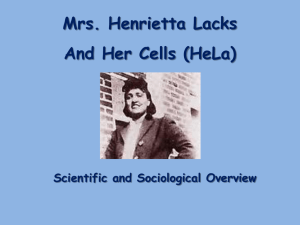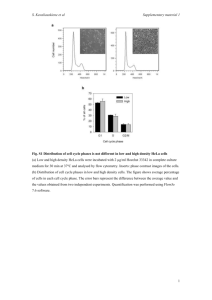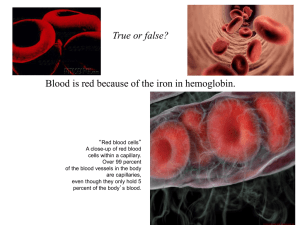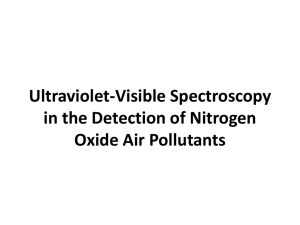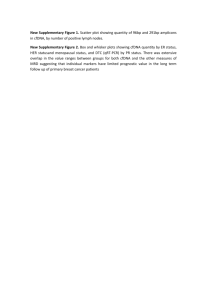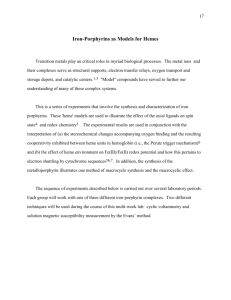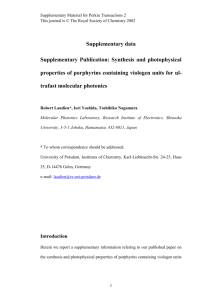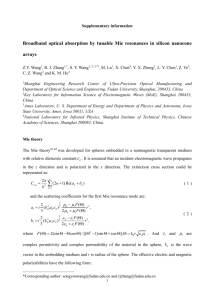Further experimental and crystallographic details
advertisement
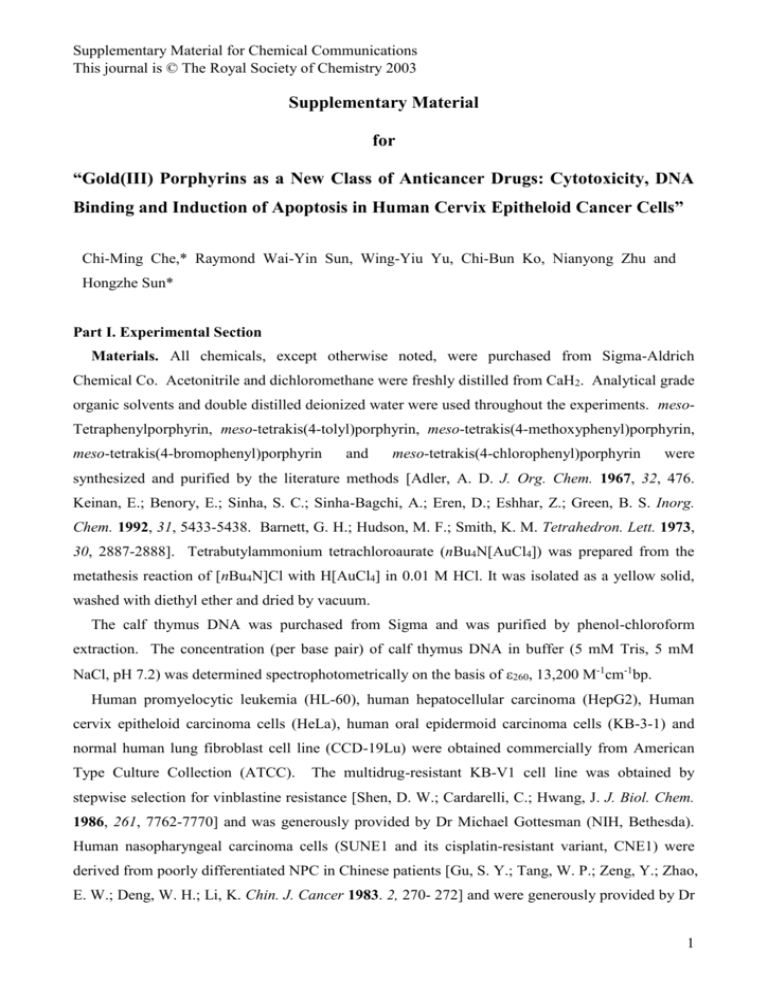
Supplementary Material for Chemical Communications This journal is © The Royal Society of Chemistry 2003 Supplementary Material for “Gold(III) Porphyrins as a New Class of Anticancer Drugs: Cytotoxicity, DNA Binding and Induction of Apoptosis in Human Cervix Epitheloid Cancer Cells” Chi-Ming Che,* Raymond Wai-Yin Sun, Wing-Yiu Yu, Chi-Bun Ko, Nianyong Zhu and Hongzhe Sun* Part I. Experimental Section Materials. All chemicals, except otherwise noted, were purchased from Sigma-Aldrich Chemical Co. Acetonitrile and dichloromethane were freshly distilled from CaH2. Analytical grade organic solvents and double distilled deionized water were used throughout the experiments. mesoTetraphenylporphyrin, meso-tetrakis(4-tolyl)porphyrin, meso-tetrakis(4-methoxyphenyl)porphyrin, meso-tetrakis(4-bromophenyl)porphyrin and meso-tetrakis(4-chlorophenyl)porphyrin were synthesized and purified by the literature methods [Adler, A. D. J. Org. Chem. 1967, 32, 476. Keinan, E.; Benory, E.; Sinha, S. C.; Sinha-Bagchi, A.; Eren, D.; Eshhar, Z.; Green, B. S. Inorg. Chem. 1992, 31, 5433-5438. Barnett, G. H.; Hudson, M. F.; Smith, K. M. Tetrahedron. Lett. 1973, 30, 2887-2888]. Tetrabutylammonium tetrachloroaurate (nBu4N[AuCl4]) was prepared from the metathesis reaction of [nBu4N]Cl with H[AuCl4] in 0.01 M HCl. It was isolated as a yellow solid, washed with diethyl ether and dried by vacuum. The calf thymus DNA was purchased from Sigma and was purified by phenol-chloroform extraction. The concentration (per base pair) of calf thymus DNA in buffer (5 mM Tris, 5 mM NaCl, pH 7.2) was determined spectrophotometrically on the basis of 260, 13,200 M-1cm-1bp. Human promyelocytic leukemia (HL-60), human hepatocellular carcinoma (HepG2), Human cervix epitheloid carcinoma cells (HeLa), human oral epidermoid carcinoma cells (KB-3-1) and normal human lung fibroblast cell line (CCD-19Lu) were obtained commercially from American Type Culture Collection (ATCC). The multidrug-resistant KB-V1 cell line was obtained by stepwise selection for vinblastine resistance [Shen, D. W.; Cardarelli, C.; Hwang, J. J. Biol. Chem. 1986, 261, 7762-7770] and was generously provided by Dr Michael Gottesman (NIH, Bethesda). Human nasopharyngeal carcinoma cells (SUNE1 and its cisplatin-resistant variant, CNE1) were derived from poorly differentiated NPC in Chinese patients [Gu, S. Y.; Tang, W. P.; Zeng, Y.; Zhao, E. W.; Deng, W. H.; Li, K. Chin. J. Cancer 1983. 2, 270- 272] and were generously provided by Dr 1 Supplementary Material for Chemical Communications This journal is © The Royal Society of Chemistry 2003 S. W. Tsao (Department of Anatomy, The University of Hong Kong, Hong Kong). Cell culture flasks and 96-well microtitre plates were purchased from Nalge Nunc Int. Culture medium, other medium constituents and phosphate buffered saline (PBS) were from Gibco BRL. Cell Proliferation Kit I (MTT) was purchased from Roche. Physical Measurement. All the absorption spectra were recorded on a Perkin-Elmer Lambda 19 or a Varian Cary 50 UV-visible spectrophotometer equipped with a PCB-150 water circulator. 1 H NMR spectra were recorded on Bruker DPX-300 or DPX-500 NMR spectrometers. Positive ion FAB mass spectra were recorded on a Finnigan MAT95 mass spectrometer. Cyclic voltammetry was performed by using a PAAR model 175 universal programmer and a Model 173 potentiostat, and the cyclic voltammograms were recorded with a Kipp & Zonen BD 90 X-Y recorder at scan rates of 200 mVs-1. Electrochemical measurements were performed using 0.1 M tetrabutylammonium hexafluorophosphate (TBAP)/acetonitrile as supporting electrolyte at room temperature after purging the solution with nitrogen. The working electrode was a glassy carbon (Atomergic Chemetal V25, geometric area of 0.35 cm2) electrode and the counter-electrode was a platinum gauze. A non-aqueous Ag/AgNO3 (0.1 M in acetonitrile) reference electrode was contained in a separate compartment connected to the test solution via fine sintered glass disks. The ferrocenium/ferrocene couple was used as internal standard. X-ray Crystal Determination. Crystals of 1a were obtained by a slow diffusion of n-pentane into a solution of 1a in chloroform. A purple crystal having dimensions 0.4 × 0.1 × 0.1 mm mounted on a glass fiber was used for data collection at 28oC on a MAR diffractometer with a 300 mm image plate detector using graphite monochromatized Mo-K radiation ( = 0.71073 Å). Data collection was made with 3o oscillation step of , 300 seconds exposure time and scanner distance at 120 mm. 48 images were collected. The images were interpreted and intensities integrated using program DENZO [Otwinowski, Z. and Minor, W. In Processing of X-ray Diffraction Data Collected in Oscillation Mode, Methods in Enzymology, Carter C. W., Sweet Jr. & R. M., Eds.; Academic Press.: 1997; Vol. 276, p. 307-326].. The structure was solved by direct methods employing SHELXS-97 program [Sheldrick, G., M. SHELX97. Programs for Crystal Structure Analysis (Release 97-2). University of Goetingen, Germany, 1997]. Au, Cl and many non-H atoms were located according to the direct methods. The positions of the other non-hydrogen atoms were found after successful refinement by the full-matrix least-squares using program SHELXL-97. Stability Analysis. The UV-vis absorption spectra of 2.5 M (7 nmoles) of all the gold(III) complexes studied in this work was monitored over 72 h in (1: 19) MeCN/ Tris buffer solution. 1HNMR experiments were carried out with a d3-MeCN/D2O (1: 9) solution of 1a (0.5 mM) in the presence of four equivalents of GSH [Sun, H.; Yan, S. C.; Cheng, W. S. Eur. J. Biochem. 2000, 2 Supplementary Material for Chemical Communications This journal is © The Royal Society of Chemistry 2003 267, 5450-5457]. The pH of the solution was adjusted to 7.4 with NaOD, and the solution was then degassed for 10 min by purging with nitrogen to minimize GSH oxidation. Biological Studies and Measurement. KB-3-1, KB-V1, HepG2 and HeLa were maintained in a minimum essential medium with Earle's balanced salts (MEM). The human cancer cell lines HL60, SUNE1 and CNE1 were maintained in the RPMI 1640 medium (Life Technologies, Inc.). All the media were supplemented with 2 mM L-glutamine and 10 % fetal bovine serum. Penicillin (100 U/mL) and streptomycin (100 g/mL) were added to all media. Cultures were incubated at 37 oC in a 5% CO2/ 95% air humidified atmosphere. Flow cytometric analysis was performed with a Coulter EPICS flow cytometer (Coulter, Miami, FL) equipped with 480 long, 525 band and 625 long pass mirrors. Samples were excited by 15 mW air-cool argon convergent laser at 488 nm. Fluorescence signals were manipulated with Coulter Elite 4.0 software (Coulter) and were analyzed by Winlist 1.04 and Modfit 5.11 software (Verity Software House, Topsham, ME). Anticancer studies of the gold(III) porphyrins. Assays on the cytotoxic effects were conducted in 96-well flat-bottomed microtitre plates. The supplemented culture medium (100 L) with cells (3 ×105 cells/ mL) was added into each well and was incubated (37 oC, 5% CO2/ 95% air) for 24 h. All the media were then removed and serum free supplemented medium (100 L) was added into each well. After further incubation for 24 h, 1a dissolved in the culture medium (100 L + < 1 % DMSO) was added into a set of wells. After mixing, the 1a-containing media (100 L) were drawn and added to another set of wells. Such processes were repeated to provide a set of two-fold dilution series. Controlled wells only contained 100 L of supplemented media. Microtitre plates were incubated at 37 oC in a 5% CO2/ 95% air humidified atmosphere for further 48 h. All the cytotoxcity assays were run in parallel with a negative control (i.e., untreated population) and a positive control using cisplatin as cytotoxic agent. Assessment of the cytotoxicity was carried out using a modified method of Mosmann based 3-(4,5-Dimethylthiazol-2-yl)-2,5-diphenyltetrazolium bromide (MTT) Assay [Mosmann, T. J. Immunol. Methods 1983, 65, 55-63]. At the end of each incubation period, 10 L of the MTT solution (Cell Proliferation Kit I, Roche) were added into each and the cultures were further incubated for 4 h at 37oC in a 5% CO2/ 95% air humidified atmosphere. Then 100 L of the solubilization solution was added into the wells to lyse the cells and solubilize the formazan complex formed. The microtitre plates were maintained in a dark, humidified chamber overnight. The formation of formazan was measured with a microtitre plate reader at 550 nm and the percentages of cell survival were determined. The cytotoxicity was 3 Supplementary Material for Chemical Communications This journal is © The Royal Society of Chemistry 2003 evaluated based on the percentage cell survival in a dose-dependence manner relative to the negative control. Absorption Titration. A solution of 1a (2.5 M ) in a DMSO/ Tris (1: 9) medium (3000 L) was placed in a thermostatic cuvette in a UV-vis spectrometer, and an absorption spectrum was recorded. Aliquots of a millimolar stock ctDNA solution were added to the gold(III) porphyrin solution and absorption spectra were recorded after equilibration for 10 min per aliquot until saturation point has reached. The intrinsic binding constant (Kb) was determined by the Scatchard equation: [ctDNA] / ap = [ctDNA] / + 1 / ( Kb), where ap = |A – B| in which A = Aobs / [1a], and = |B – F| with B and F corresponding to the extinction coefficients of the DNAbound and –unbound 1a, respectively. Confocal Microscopic Experiment. A monolayer of HeLa cells was incubated in the presence of 1a (0.5 M) at 37 oC and 5% CO2 for 15 hours. After 15 h, the cell culture (in 1 mL culture medium) was stained with of the AO/EB solution (40 L, containing 2 g AO and 2 g EB in phosphate buffer). The staining procedure was carried out just before microscopic examination and the samples were examined immediately by using a laser confocal microscope (Zeiss Axiovert 100M). Flow Cytometric Studies of the Gold(III) Porphyrin-induced Apoptosis. HeLa cells (100K cells/ mL) were cultured in two separate 60-mm tissue culture dishes with 1 mL of culture medium per dish. Complex 1a (0.5 M) was added to the dishes after 24 h incubation in the 5% CO2/ 95% air humidified atmosphere. The plates were then further incubated for 2, 6, 15 or 24 h more. AnnexinV / propidium iodide staining was performed by following the Annexin-V-Fluos Staining Kit user’s manual provided by Roche. Preparation of Gold(III) Porphyrin Complexes. The synthesis of the gold(III) porphyrins was conducted under a nitrogen atmosphere using the standard Schlenk technique. Complexes 1a-e were prepared according to the literature method with some modifications [MacCragh, A.; Koski, W. S. J. Am. Chem. Soc. 1965, 87, 2496. Fleischer, E. B.; Laszlo, A. Inorg. Nucl. Chem. Lett. 1969, 5, 373-376]. In general, K[AuCl4] or nBu4N[AuCl4] (0.508 mmol) and sodium acetate (2.538 mmol) were heated to 80 oC in acetic acid (20 mL) for 15 minutes. A solution of free porphyrin (0.406 mmol) in acetic acid (10 mL) was added dropwise. The mixture was heated under reflux for 0.5 to 2 h; complete metallation was checked by disappearance of the Q band using UV-Vis spectrophotometry. Upon removal of solvent by vacuum, the residue was dissolved in CH2Cl2 (40 mL). The CH2Cl2 solution was washed twice with water (2 × 40 mL) to remove any unreacted KAuCl4 and NaOAc, and concentrated to ca. 3 mL. It was chromatographed on a neutral 90alumina packed column with CH2Cl2 as eluant to remove the unreacted free base porphyrin, and the 4 Supplementary Material for Chemical Communications This journal is © The Royal Society of Chemistry 2003 gold(III) porphyrin complex was then eluted using a CH2Cl2/ MeOH (99:1, v/v) mixture. A reddish-purple solid was obtained after solvent evaporation and the complex was recrystallized from a CHCl3/ petroleum ether (1:1, v/v) mixture. (1a) UV-vis (CH2Cl2) max/nm (log : 409 (5.68), 521 (4.73). 1H NMR (CDCl3): 9.28 (s, 8H), 7.89 (m, 8H), 8.24 (d, 8H) 7.89 (m, 4H). m/z = 809. Yield 70%. Anal. Calcd. for C44H28N4ClAu (%): C, 62.53; H, 3.34; N, 6.63. Found: C, 62.50; H, 3.61; N, 6.74. (1b) UV-vis (CH2Cl2) max/nm (log : 413 (5.41), 522 (4.62). 1H NMR (CDCl3): 9.29 (s, 8H), 7.67 (d, 8H), 8.10 (d, 8H) 2.75 (s, 12H). m/z = 865. Yield 69%. Anal. Calcd. for C48H36N4ClAu (%): C, 63.97; H, 4.03; N, 6.22. Found: C, 63.82; H, 4.39; N, 5.82. (1c) UV-vis (CH2Cl2) max/nm (log : 423 (5.26), 527 (4.34). 1H NMR (CDCl3): 9.31 (s, 8H), 7.38 (d, 8H), 8.13 (d, 8H) 4.13 (s, 12H). m/z = 929. Yield 63%. Anal. Calcd for C48H36N4O4ClAu (%): C, 59.73; H, 3.76; N, 5.80. Found: C, 59.55; H, 3.49; N, 5.99. (1d) UV-vis (CH2Cl2) max/nm (log : 411 (5.53), 522 (4.48). 1H NMR (CDCl3): 9.24 (s, 8H), 7.80 (d, 8H), 8.14 (d, 8H). m/z = 1125. Yield 60%. Anal. Calcd. for C44H24N4Br4ClAu (%): C, 45.53; H, 2.08; N, 4.83. Found: C, 46.01; H, 2.35; N, 4.79. (1e) UV-vis (CH2Cl2) max/nm (log : 409 (5.47), 520 (4.34). 1H NMR (CDCl3): 9.23 (s, 8H), 7.88 (d, 8H), 8.20 (d, 8H). m/z = 947. Yield 61%. Anal. Calcd. for C44H24N4Cl5Au (%): C, 53.77; H, 2.46; N, 5.70. Found: C, 53.46; H, 2.72 N, 5.68. 5 Supplementary Material for Chemical Communications This journal is © The Royal Society of Chemistry 2003 Part II. Figures and Tables C(25) C(24) C(23) C(22) C(11) C(10) C(9) C(8) N(2*) N(2) C(21) C(7) C(6) C(20) C(19) Au N(1*) N(1) C(16) C(5) C(17) C(18) C(4) C(2) C(3) C(1) C(12) C(13) C(14) C(15) Figure S2. ORTEP drawing of [AuIII(TPP)]ClO4 with atom-numbering scheme. Hydrogen atoms and the perchlorate ion are omitted for clarity. Thermal ellipsoids are drawn at the 30% probability level. Selected bond distances (Å): Au-N(1), 2.032(5) and AuN(2), 2.033(5). Selected bond angles (º): N(1)-Au-N(1*), 89.8(3); N(1)-Au-N(2*), 177.31(19); N(1*)-Au-N(2*), 90.1(2); N(1)-Au-N(2), 90.1(2); N(1*)-Au-N(2), 177.31(19) and N(2*)-Au-N(2), 90.1(3) 6 Supplementary Material for Chemical Communications This journal is © The Royal Society of Chemistry 2003 a 0.6 b absorbance/ arb. unit 0.4 0.2 0.0 400 600 800 /nm Figure S2. UV-visible spectra of [AuIII(TPP)]Cl (5.0 μM) in Tris buffer/MeCN (19:1) at (a) time = 0 h and (b) time = 48 h. a b absorbance/ arb. unit 0.2 0.1 400 500 600 700 /nm Figure S3. UV-visible spectra of [AuIII(TPP)]Cl (2.5 μM) in 2 mM GSH Tris buffer/MeCN (19:1) at (a) time = 0 h and (b) time = 48 h. 7 Supplementary Material for Chemical Communications This journal is © The Royal Society of Chemistry 2003 % survival of cells (vs control)/ % 100 CCD-19Lu HeLa 80 60 40 20 0 1E-7 1E-6 1E-5 dose concentration/ M Figure S4. Cytotoxicity profiles of (a) normal human lung fibroblast cell line (CCD19-Lu) and (b) human cervix epitheloid carcinoma (HeLa) toward [AuIII(TPP)]Cl (1a). Graphs show the percentage of growth compared to control upon incubation of increasing amounts of the complex. IC50 = 0.28 M for HeLa and IC50 = 0.91 M (CCD-19Lu). 8 Supplementary Material for Chemical Communications This journal is © The Royal Society of Chemistry 2003 Figure S5. UV-vis spectral changes of [AuIII(TPP)]Cl in Tris buffer (5 mM Tris, 5 mM NaCl, pH 7.2) with increasing concentration of ctDNA: (a) r = 0, (b) r = 0.21, (c) r = 0.41, (d) r = 0.62, (e) r = 0.83, (f) r = 1.03, (g) r = 1.24, and (h) r = 1.45 at 292.8 K. Inset: plot of [ctDNA] / Δεap vs [ctDNA]. Absorbance was monitored at 410 nm 9 Supplementary Material for Chemical Communications This journal is © The Royal Society of Chemistry 2003 (a) Figure S6. (b) Laser confocal micrographs of the HeLa cells treated with [Au III(TPP)]Cl (0.5 M) at time interval of (a) 0 h and (b) 15 h. The formation of apoptotic bodies are marked by a red circle PI emission Figure S7. annexin-V FITC emission annexin-V FITC emission annexin-V FITC emission (a) (b) (c) Flow cytometric studies of the [AuIII(TPP)]Cl (1a)-induced apoptosis of the HeLa cells. Plots show the occurrence of events as functions of propidium iodide (PI; yaxis) and annexin V-fluorescein (x-axis) fluorescence intensities. Panel (a) shows the fluorescent data for the untreated cells as negative control, corresponding to 9.8 % apoptotic cells after 15 h incubation. Panels (b) and (c) show the fluorescent data 10 Supplementary Material for Chemical Communications This journal is © The Royal Society of Chemistry 2003 for the cells treated with 1a (0.5 M), corresponding to 24.6% (time = 6 h) and 57.3% (time = 15 h) apoptotic cells respectively Table S1. Reduction potentials of [AuIII(p-Y-TPP)]Cl entry Y couple I [a]/V couple II [a]/V 1 2 3 4 5 Cl Br H Me OMe -0.96 -0.97 -1.00 -1.01 -1.02 -1.44 -1.45 -1.48 -1.49 -1.51 [a] Couples I and II (vs Cp2Fe+/0) correspond to the first and second reductions of [AuIII(p-Y-TPP)]Cl respectively. Table S2. Crystallographic Data for [AuIII(TPP)]ClO4 empirical formula formula weight temperature wavelength crystal system space group unit cell dimensions volume Z density (calculated) absorption coefficient F(000) crystal size theta range for data collection index ranges reflections collected independent reflections completeness to theta = 25.63o absorption correction refinement method data / restraints / parameters goodness-of-fit on F2 final R indices [I>2sigma(I)] R indices (all data) largest diff. peak and hole C44H28AuClN4O4 909.12 253(2) K 0.71073 Å Orthorhombic Pnna a= 8.1020(16) Å α= 90o b= 20.964(4) Å β= 90o c= 20.060(4) Å γ= 90o 3407.2(12) Å 4 1.772 mg/m3 4.451 mm-1 1792 0.4 x 0.1 x 0.1 mm 3 1.40 to 25.63o -9<=h<=9, -24<=k<=25, -24<=l<=24 13426 3006 [R(int) = 0.0478] 95.3 % None Full-matrix least-squares on F2 3066 / 0 / 248 0.934 R1 = 0.0308, wR2 = 0.0790 R1 = 0.0645, wR2 = 0.1040 0.716 and –1.590 e Å-3 11 Supplementary Material for Chemical Communications This journal is © The Royal Society of Chemistry 2003 Table S3. Percentage apoptotic and necrotic/late-apoptotic cell death induced by 1a incubation time (h) apoptosis (%) necrosis /late apoptosis (%) blank (-ve control) - 4.4 2.6 straurosporine (+ve control) 2 6 15 24 27.7 55.1 76.9 21.9 3.0 1.9 0.3 29.3 1a (IC40) 2 6 15 24 8.6 19.4 32.4 24.1 3.4 1.7 4.7 30.1 1a (IC60) 2 6 15 24 27.7 45.6 64.2 19.1 4.8 1.5 2.4 32.3 Table S4. IC50 ratios for [Pt(NH3)2Cl2] and the Au(III) porphyrins IC50 ratio [Pt(NH3)2Cl2 / Au(III) porphyrins] entry compound KB-3-1 HeLa SUNE1 KB-V1 CNE1 1 2 3 4 5 1a 1b 1c 1d 1e 17.8 32.1 n.d.[a] 10.3 26.4 40.0 21.5 17.0 12.6 16.2 114.5 11.5 18.5 17.0 37.1 25.1 18.4 n.d.[a] 8.96 20.4 240.2 41.2 53.0 41.6 99.5 [a] n.d. = not determined 12
